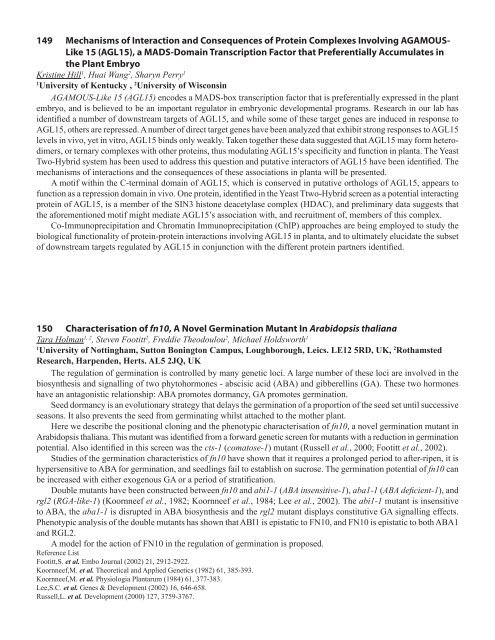75 Integrating Membrane Transport with Male Gametophyte ... - TAIR
75 Integrating Membrane Transport with Male Gametophyte ... - TAIR
75 Integrating Membrane Transport with Male Gametophyte ... - TAIR
You also want an ePaper? Increase the reach of your titles
YUMPU automatically turns print PDFs into web optimized ePapers that Google loves.
149 Mechanisms of Interaction and Consequences of Protein Complexes Involving AGAMOUS-<br />
Like 15 (AGL15), a MADS-Domain Transcription Factor that Preferentially Accumulates in<br />
the Plant Embryo<br />
Kristine Hill 1 , Huai Wang 2 , Sharyn Perry 1<br />
1<br />
University of Kentucky , 2 University of Wisconsin<br />
AGAMOUS-Like 15 (AGL15) encodes a MADS-box transcription factor that is preferentially expressed in the plant<br />
embryo, and is believed to be an important regulator in embryonic developmental programs. Research in our lab has<br />
identified a number of downstream targets of AGL15, and while some of these target genes are induced in response to<br />
AGL15, others are repressed. A number of direct target genes have been analyzed that exhibit strong responses to AGL15<br />
levels in vivo, yet in vitro, AGL15 binds only weakly. Taken together these data suggested that AGL15 may form heterodimers,<br />
or ternary complexes <strong>with</strong> other proteins, thus modulating AGL15’s specificity and function in planta. The Yeast<br />
Two-Hybrid system has been used to address this question and putative interactors of AGL15 have been identified. The<br />
mechanisms of interactions and the consequences of these associations in planta will be presented.<br />
A motif <strong>with</strong>in the C-terminal domain of AGL15, which is conserved in putative orthologs of AGL15, appears to<br />
function as a repression domain in vivo. One protein, identified in the Yeast Ttwo-Hybrid screen as a potential interacting<br />
protein of AGL15, is a member of the SIN3 histone deacetylase complex (HDAC), and preliminary data suggests that<br />
the aforementioned motif might mediate AGL15’s association <strong>with</strong>, and recruitment of, members of this complex.<br />
Co-Immunoprecipitation and Chromatin Immunoprecipitation (ChIP) approaches are being employed to study the<br />
biological functionality of protein-protein interactions involving AGL15 in planta, and to ultimately elucidate the subset<br />
of downstream targets regulated by AGL15 in conjunction <strong>with</strong> the different protein partners identified.<br />
150 Characterisation of fn10, A Novel Germination Mutant In Arabidopsis thaliana<br />
Tara Holman 1, 2 , Steven Footitt 2 , Freddie Theodoulou 2 , Michael Holdsworth 1<br />
1<br />
University of Nottingham, Sutton Bonington Campus, Loughborough, Leics. LE12 5RD, UK, 2 Rothamsted<br />
Research, Harpenden, Herts. AL5 2JQ, UK<br />
The regulation of germination is controlled by many genetic loci. A large number of these loci are involved in the<br />
biosynthesis and signalling of two phytohormones - abscisic acid (ABA) and gibberellins (GA). These two hormones<br />
have an antagonistic relationship: ABA promotes dormancy, GA promotes germination.<br />
Seed dormancy is an evolutionary strategy that delays the germination of a proportion of the seed set until successive<br />
seasons. It also prevents the seed from germinating whilst attached to the mother plant.<br />
Here we describe the positional cloning and the phenotypic characterisation of fn10, a novel germination mutant in<br />
Arabidopsis thaliana. This mutant was identified from a forward genetic screen for mutants <strong>with</strong> a reduction in germination<br />
potential. Also identified in this screen was the cts-1 (comatose-1) mutant (Russell et al., 2000; Footitt et al., 2002).<br />
Studies of the germination characteristics of fn10 have shown that it requires a prolonged period to after-ripen, it is<br />
hypersensitive to ABA for germination, and seedlings fail to establish on sucrose. The germination potential of fn10 can<br />
be increased <strong>with</strong> either exogenous GA or a period of stratification.<br />
Double mutants have been constructed between fn10 and abi1-1 (ABA insensitive-1), aba1-1 (ABA deficient-1), and<br />
rgl2 (RGA-like-1) (Koornneef et al., 1982; Koornneef et al., 1984; Lee et al., 2002). The abi1-1 mutant is insensitive<br />
to ABA, the aba1-1 is disrupted in ABA biosynthesis and the rgl2 mutant displays constitutive GA signalling effects.<br />
Phenotypic analysis of the double mutants has shown that ABI1 is epistatic to FN10, and FN10 is epistatic to both ABA1<br />
and RGL2.<br />
A model for the action of FN10 in the regulation of germination is proposed.<br />
Reference List<br />
Footitt,S. et al. Embo Journal (2002) 21, 2912-2922.<br />
Koornneef,M. et al. Theoretical and Applied Genetics (1982) 61, 385-393.<br />
Koornneef,M. et al. Physiologia Plantarum (1984) 61, 377-383.<br />
Lee,S.C. et al. Genes & Development (2002) 16, 646-658.<br />
Russell,L. et al. Development (2000) 127, 3<strong>75</strong>9-3767.





